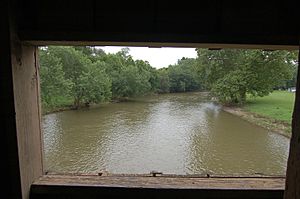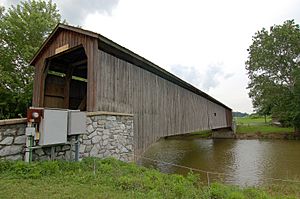Conestoga River facts for kids
Quick facts for kids Conestoga River |
|
|---|---|

The Conestoga River as seen from the inside of Hunsecker's Mill Covered Bridge in Lancaster County
|
|
| Physical characteristics | |
| Main source | State Game Lands 52, Lancaster and Berks County, Pennsylvania 800 ft (240 m) 40°10′47″N 75°56′32″W / 40.17972°N 75.94222°W |
| River mouth | Susquehanna River, Safe Harbor, Lancaster County, Pennsylvania 170 ft (52 m) 39°55′31″N 76°23′3″W / 39.92528°N 76.38417°W |
| Length | 61.6 miles (99.1 km) |
| Basin features | |
| Basin size | 491 square miles (1,270 km2) |
| Tributaries |
|
The Conestoga River is a 61.6-mile-long river in Pennsylvania. It is also known as Conestoga Creek. This river flows through the middle of Lancaster County. It is a tributary of the Susquehanna River.
Contents
River's Path and Size
The Conestoga River starts in southern Berks County and northeastern Lancaster County. This area is sometimes called "Bortz's Swamp." A small part of the river also begins in Chester County.
Where the River Begins
The East Branch and West Branch of the Conestoga join together. This happens just north of Morgantown. From there, the river flows from the northeast to the southwest. It travels for over 60 miles. The river passes close to the city of Lancaster. It finally ends at Safe Harbor. This spot is along the Susquehanna River. It is about 16 miles north of the Pennsylvania-Maryland state line.
River Branches and Area
The main streams that flow into the Conestoga River are Cocalico Creek, Mill Creek, and Little Conestoga Creek. These streams add their water to the Conestoga River. The Conestoga River and its main branches cover about 114 miles of stream. The total area that drains into these streams is called a watershed. This watershed is about 491 square miles.
River's Interesting History
The Conestoga River was named after a group of indigenous people. They were called the Susquehannock people. The English in Pennsylvania called them the Conestoga. Their village was named Kanastoge, which means "place of the immersed pole."
Early People and the River
In the 1600s, the village of Conestoga had many people. Some reports say there were 2,000 residents. The entire Conestoga River watershed might have been home to 7,000 people or more. By the early 1700s, many Susquehannock people moved to the Ohio area. Their community changed over time. In 1763, the remaining Susquehannock people at Conestoga faced difficult times. Their community was greatly affected by a group called the Paxton Boys.
River's Famous Inventions
The first steamboat in America floated on the Conestoga River in 1763. This was a very early step in boat travel! Later, in the 1800s, the river's name became even more famous. This was because of the Conestoga wagon. These wagons were first built in this valley. They helped move goods across the eastern United States. They were also used to transport items to the western frontier.
Many cigars were made in the river's area in the late 1800s. A local cigar called the Conestoga became very well known. It was even nicknamed the "stogie" across the country. In the early 1800s, boats could travel from Chesapeake Bay to Lancaster city. This was possible using a system of locks. Even though the Conestoga is smaller than most rivers, it was called a river. This was because steamboat service went to a local amusement park, Rocky Springs, along its banks.
Other Uses of the Name
The name "Conestoga" has been used for other things too. It was used for the Conestoga Rocket. This rocket was made from Minuteman I parts. It was launched from Matagorda Island. There is also a ship called Conestoga. This ship is a popular diving spot in the Thousand Islands. The C-93 Conestoga was a cargo airplane. In the TV show Star Trek, a starship was named Conestoga. It was used in an early attempt to explore deep space.
River's Environment and Surroundings
The land around the Conestoga River has mostly been used for farming. However, more towns and cities are growing in the area. This growth can cause problems like erosion. The Conestoga River is a beautiful place. But it has some pollution from nitrogen and phosphorus. This pollution mostly comes from animal waste and too much fertilizer used on farms.
Pollution and Conservation
Other sources of pollution include dirt from farming and construction. Water runoff from cities also adds to the problem. The river flows through a peaceful landscape. Many Pennsylvania German farmers work the land there. The river also runs along the eastern and southern edges of Lancaster city.
Features Along the River
Many covered bridges cross the Conestoga River. Northeast of Lancaster city, you can find many Old Order Amish and Old Order Mennonite farms. Horse and carriage traffic is common on the local roads. Many small dams hold back the river's water. Most of these dams were built a long time ago. They were used to power mills or make electricity. Many dams are now old and not used. There is a movement to remove as many as possible. Seven dams were removed between 1996 and 1999.
River Crossings
Many bridges cross the Conestoga River. Some are very old and famous.
Covered Bridges
- Hunsecker's Mill Covered Bridge [1]
- Pinetown Bushong's Mill Covered Bridge [2]
- Pool Forge Covered Bridge [3]
- Kurtz's Mill Covered Bridge [4] (This bridge used to cross the Conestoga River before it was moved.)
- Zook's Mill Covered Bridge [5] (This bridge crosses Cocalico Creek, which flows into the Conestoga.)
- Bitzer's Mill Covered Bridge
- Weaver's Mill Covered Bridge
- Pool Forge Covered Bridge
Other Bridges
- Safe Harbor Bridge (part of the Enola Low Grade railway)
- Conestoga Creek Viaduct (a stone arch railroad bridge)
- Bridge in West Earl Township (a concrete bridge)
- Weaverland Bridge (a concrete bowstring arch truss bridge)


